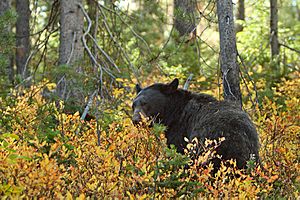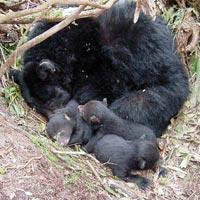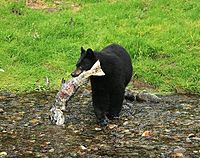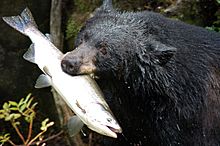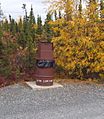American Black Bear facts for kids
Quick facts for kids American Black BearTemporal range: early Pleistocene
|
|
|---|---|
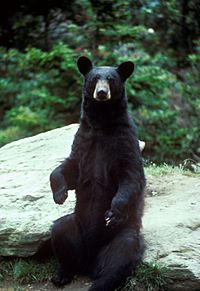 |
|
| American Black Bear | |
| Conservation status | |
| Scientific classification | |
| Kingdom: | |
| Phylum: | |
| Class: | |
| Order: | |
| Family: | |
| Genus: | |
| Species: |
U. americanus
|
| Binomial name | |
| Ursus americanus Pallas, 1780
|
|
 |
|
The American black bear (scientific name Ursus americanus) is North America's smallest and most common bear. These bears are omnivores, meaning they eat both meat and plants. Black bears usually live in forests. However, they sometimes leave forests to find food. They might even come close to people if food is scarce.
The IUCN says the American black bear is of "Least Concern." This is because there are many black bears around the world. Their population is thought to be twice as big as all other bear species combined! These bears are usually shy. In the last 100 years, only 37 people have been killed by them.
American black bears often hibernate during winter. When they hibernate, their bodies slow down a lot. Their metabolism (how their body uses energy) and heart rate both drop. A black bear's heart can even stop for 20 seconds during hibernation! Their body temperature also goes down to about 31 °C (88 °F). When winter is over, their body temperature goes back to normal.
Contents
Types of Black Bears
Scientists have found 16 different types, or subspecies, of American black bears. However, some recent studies suggest that not all of them are truly separate types. Here are a few examples:
| Image | Scientific name | Common name | Where they live |
|---|---|---|---|
 |
Ursus americanus altifrontalis | Olympic black bear | Along the Pacific Northwest coast, from British Columbia to northern California. |
 |
Ursus americanus amblyceps | New Mexico black bear | In states like Colorado, New Mexico, and Arizona. |
 |
Ursus americanus americanus | Eastern black bear | Across Eastern Canada and the eastern U.S.. Most of these bears have black fur. |
 |
Ursus americanus cinnamomum | Cinnamon bear | In states like Colorado, Idaho, and Wyoming. These bears have brown or reddish-brown fur. |
 |
Ursus americanus emmonsii | Glacier bear or blue bear | Found in Southeastern Alaska. Their fur is silvery-gray with a blue shine. |
 |
Ursus americanus floridanus | Florida black bear | In Florida and parts of Georgia, Alabama, and Mississippi. They often have a white patch on their chest. |
 |
Ursus americanus kermodei | Kermode bear or spirit bear | On the central coast of British Columbia. About 10% of these bears have white or cream-colored fur. |
Where Black Bears Live
In the past, American black bears lived in most forested areas of North America. They often prefer places that are hard to reach. These areas have lots of thick plants and plenty of food, especially nuts and berries.
In some parts of northeastern Canada, like Labrador, black bears live in more open areas. This is unusual for them. It might be because there are no brown bears or polar bears there.
What Black Bears Look Like
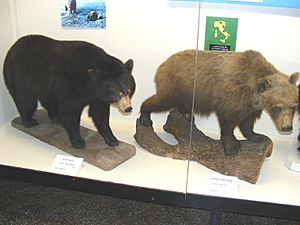
Black bears have narrow snouts and strong jaws. Female bears often have thinner, more pointed faces than males. Their claws are usually black or grayish-brown. Their hind legs are longer than those of Asian black bears. They have a small tail, about 7.7 to 17.7 cm long. Their ears are small, round, and set back on their heads.
American black bears are very strong. A bear weighing 120 pounds (54 kg) was seen flipping over rocks weighing 310 to 325 pounds (140 to 147 kg) with one paw! They walk smoothly and can run very fast, up to 25 to 30 miles per hour (40 to 48 km/h).
How Big Are They?

Adult black bears are usually 120 to 200 cm long from head to body. They stand 70 to 105 cm tall at the shoulder. Even though they are the smallest bear species in North America, very large males can be bigger than most other bear species. Only brown bears and polar bears are generally larger.
Adult males typically weigh between 57 and 250 kg. Females are about one-third lighter, weighing 41 to 170 kg.
The biggest wild American black bear ever recorded was a male from New Brunswick. It was shot in 1972 and weighed an estimated 500 kg (1,100 pounds) when alive. It was also 2.41 meters (7.9 feet) long. The North American Bear Center in Ely, Minnesota, has the largest captive male and female black bears. Ted, the male, weighed 431 to 453.5 kg (950 to 1,000 pounds) in 2006. Honey, the female, weighed 219.6 kg (484 pounds) in 2007.
Their Fur

Black bears have soft fur with a thick undercoat. Their outer guard hairs are long, coarse, and thick. Their fur is not as shaggy as a brown bear's. You can tell a black bear's skin from an Asian black bear's because black bears don't have a white patch on their chest and their footpads are hairier.
Even though they are called "black bears," their fur can be many different colors. It can be white, blonde, cinnamon, light brown, dark chocolate brown, or jet black. There are many shades in between these colors too.
How Black Bears Behave
American black bears have good eyesight and hearing, similar to humans. They can quickly learn to tell apart different shapes like triangles, circles, and squares.
Their best sense is smell. It is about seven times better than a domestic dog's! They are also excellent and strong swimmers. They swim for fun and to catch fish. Black bears often climb trees to find food, escape danger, and hibernate.
American black bears are very clever with their paws. They can open screw-top jars and even manipulate door latches! They can be active at any time of day or night. However, they mostly look for food at night.
Bear Sounds
Bears use many different sounds to talk to each other. Clicking their tongue and grunting are common sounds. When they are relaxed, they make a loud, rumbling hum. If they are scared or nervous, bears might moan, huff, or blow air. Warning sounds include jaw-clicking and lip-popping. When bears are fighting, they make deep, rumbling calls that sound like growling. Baby bears (cubs) squeal, bawl, or scream when they are worried. They make a motor-like humming sound when they are comfortable or drinking milk from their mother. American black bears often mark trees with their teeth and claws. This is a way for them to communicate with other bears.
Babies and Growing Up
Female black bears usually have their first babies when they are 3 to 5 years old. The time they can have babies lasts for two to three months. A mother bear usually has two or three cubs, but can have anywhere from one to six.
When cubs are born, they are very small. They weigh about 280 to 450 grams (0.6 to 1 pound) and are about 20.5 cm (8 inches) long. They have thin, gray, fuzzy hair and their back legs are not fully developed. They usually open their eyes after 28 to 40 days. They start walking after about 5 weeks. Cubs drink their mother's milk for about 30 weeks. They become independent when they are 16 to 18 months old. By 6 weeks, they weigh about 900 grams (2 pounds). By 8 weeks, they reach 2.5 kg (5.5 pounds). At 6 months, they weigh 18 to 27 kg (40 to 60 pounds). They can have their own babies when they are 3 years old. They reach their full size at 5 years old.
How Long Do They Live?
In the wild, black bears usually live for about 18 years. Some wild bears can live for more than 23 years. The oldest wild black bear ever found lived to be 39 years old! In zoos, black bears have lived even longer, with the record being 44 years.
Who Hunts Black Bears?
Adult black bears usually don't have many natural enemies. Sometimes, a large brown bear or a pack of gray wolfes might attack them. In the southern parts of their home range, jaguars might occasionally hunt adult black bears. In these cases, the jaguar would likely win.
Baby cubs are much more at risk. Predators of cubs include bobcats, coyotes, cougars, gray wolves, brown bears, and even other black bears.
Winter Sleep (Hibernation)
Bears go into their dens in October and November. However, in warmer southern areas, only pregnant females and mothers with young cubs will hibernate. Before hibernating, they can gain up to 30 pounds (13.6 kg) of body fat. This fat helps them survive the months they spend sleeping without eating. Hibernation usually lasts 3 to 8 months, depending on how cold the area is.
Hibernating bears find dens in hollow trees, under logs or rocks, in caves, or in shallow holes. While they might use natural dens, most bears dig their own. During hibernation, a black bear's heart rate drops from 40-50 beats per minute to only 8 beats per minute. Their body's energy use can drop to a quarter of its normal rate. Their internal clock stays active during hibernation. This helps the bear know when the days are changing based on the temperature. This way, they wake up at the right time of year to save as much energy as possible.
The time black bears wake up from hibernation changes. It depends on things like temperature, floods, and how hungry they are. In southern areas, they might wake up in mid-winter. Further north, they might not be seen until late March, April, or even early May. Bears at lower elevations tend to wake up earlier. Older male bears usually come out first, then younger males and females, and finally mothers with cubs. Mothers with cubs born the previous year are seen before those with newborn cubs.
What Black Bears Eat
Up to 85% of a black bear's diet is plants. They don't dig for roots and bulbs as much as brown bears do. When they first wake up from hibernation, they look for dead animals that died in winter. They also look for newborn deer or other young animals. As spring gets warmer, black bears eat new shoots of many plants, like fresh grasses and wetland plants. Young shoots and buds from trees and bushes in spring are very important. They help bears rebuild muscle and strengthen their bones. These are often the only foods they can digest at that time. In summer, they mostly eat fruits, especially berries and soft nuts like drupes.
In the fall, they love to eat nuts like hazelnuts, oak acorns, and whitebark pine nuts. A single bear can eat hundreds of these nuts every day! During fall, bears might also steal nuts that tree squirrels have hidden. Berries like huckleberries and buffalo berries are also very important in the fall.
Most of their diet also includes insects. These include bees, yellow jackets, ants, beetles, and their larvae (baby insects). American black bears also love honey. They will chew through trees if beehives are too deep inside for them to reach with their paws. Once they get to the hive, they scrape the honeycombs with their paws and eat them, even if they get stung by bees. Bears living in northern coastal areas (especially the Pacific Coast) will fish for salmon at night. Their black fur makes them easy for salmon to spot during the day.
Even though black bears don't often hunt large animals, they will eat baby mule and white-tailed deer in the spring if they get the chance. They also easily eat eggs and baby birds from nests. They can even climb to reach large nests, like those of bald eagles. Bears have also been known to steal deer and other game from human hunters.
Images for kids
-
American black bear head, Cincinnati Zoo and Botanical Garden
-
A possible American black bear-grizzly bear hybrid in the Yukon Territory, Canada
-
Harry Colebourn and Winnipeg, the bear from which Winnie-the-Pooh got his name
See also
 In Spanish: Oso negro americano para niños
In Spanish: Oso negro americano para niños



